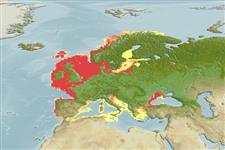Preferred temperature (Ref.
123201): 7 - 12.2, mean 9.4 °C (based on 464 cells).
Phylogenetic diversity index (Ref.
82804): PD
50 = 0.5001 [Uniqueness, from 0.5 = low to 2.0 = high].
Bayesian length-weight: a=0.00631 (0.00462 - 0.00861), b=3.05 (3.01 - 3.09), in cm total length, based on LWR estimates for this species (Ref.
93245).
Nível Trófico (Ref.
69278): 3.2 ±0.0 se; based on diet studies.
Generation time: 1.2 ( na - na) years. Estimated as median ln(3)/K based on 2
growth studies.
Resiliência (Ref.
120179): Médio, tempo mínimo de duplicação da população 1,4 - 4,4 anos (K=0.93; tm=0.7; tmax=2.7; fec = 5,231).
Fishing Vulnerability (Ref.
59153): Low vulnerability (15 of 100).
Nutrients (Ref.
124155): Calcium = 101 [56, 258] mg/100g; Iron = 0.552 [0.269, 1.104] mg/100g; Protein = 18.2 [16.1, 19.8] %; Omega3 = 0.818 [0.358, 1.667] g/100g; Selenium = 11.6 [5.2, 35.1] μg/100g; VitaminA = 17.1 [4.9, 59.8] μg/100g; Zinc = 1.04 [0.71, 1.56] mg/100g (wet weight);
